AquaMaps Suite
The AquaMaps suite is a dedicated environment supporting the production of AquaMaps products, i.e. compound objects containing species and biodiversity occurrence predictive maps. Thus it is one of the main tool for supporting the AquaMaps Scenario.
This suite provides its users with the following facilities:
- a rich array of target species and Areas selection functionality;
- target species envelopes customization functionality;
- target data sources (HCAF, HSPEN, HSPEC) selection functionality;
- AquaMaps object generation functionality, i.e. the execution and monitoring of various tasks aiming at producing the various maps that might result from the selected target species, areas and data sources and leading to various AquaMaps products (both species distribution maps and biodiversity maps);
- browsing of the produced AquaMaps objects and their constituents;
- storage of the AquaMaps objects into the user Workspace;
AquaMaps Suite User Interface
The AquaMaps user interface is organised in four main tabs driving the user through the workflow steps leading to the production of AquaMaps objects. Each tab support one or more of the facilities described above. In particular:
- Species Selection: supports the facilities for species selection and species envelop customisation;
- Area Selection: provides for
- Maps Generation: supports
- View AquaMaps Results: supports
AquaMaps Suite Functionality
Species Selection
In this section of the GUI users can select species, filtering all known species by various constraints and adding them to their basket.
Search Result

This grid displays all species that match specified search criteria (see Filter Panel), and its columns let users to sort them by different attributes :
- Genus - shown by default
- Species - shown by default
- Family - shown by default
- FB Name - shown by default
- Species ID
- Species Code
- Scientific Name
- English Name
- French Name
- Spanish Name
- Kingdom
- Phylum
- Class
- Order
- Deep Water
- Angling
- Mammal
- Diving
- Dangerous
- Invertebrate
- Algae
- Sea Bird
- Fresh Water
By double clicking on a species row, the portlet opens a new Window in the browser, linked to the FishBase page about the double-clicked species.
In the bottom toolbar of this panel users can find (from left to right) :
- Refresh Button - reloads the list using the current settings
- Add Selected - adds the selected species to the user basket
- Select All / Invert Selection - inverts the selection if any, otherwise selects all found species
- Add All - Adds all found species to the user basket
Filter Panel
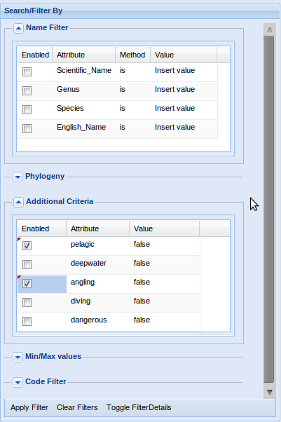
In this panel users can define criteria by which filter species in Search Result.
Available filters are divided in :
- Name Filter - filters species by checking if their Scientific Name, Genus, Species, English Name "contains" OR "begin with" OR "is" the specified value
- Phylogeny - filters species by checking their phylogeny classification at Kingdom, Phylum, Class, Order or Family level
- Additional Criteria - filters species by checking if they are OR are-not pelagic, deep water, angling, diving, dangerous
- Min/Max values - filters species by checking if their envelopes parameters (Depth, Temperature, Salinity, Ice Concentration and Primary Production) are in a specified range
- Code - filters species by checking if their Species Id "contains" OR "begin with" OR "is" the specified value
Every filter can be enabled / disabled by clicking in the related checkbox.
Since there could be enabled filters that aren't visible (i.e. a subsection is collapsed), users can activate the Active Filter Summary, which displays which filters are currently enabled.

In the bottom toolbar of this panel users can find (from left to right):
- Apply Filter - Apply all currently enabled filters to the Search Result section
- Clear Filters - Disables all filters and remove them (if any) from the Search Result section
- Toggle Details - Activate / Deactivate the Active Filter Summary
Species Basket

Similarly to Search Result this grid displays the species which will be used to generate maps.
In the bottom toolbar of this panel users can find (from left to right) :
- Refresh Button - reloads the list
- Remove Selected - removes the selected species from the user basket
- Select All / Invert Selection - inverts the selection if any, otherwise selects all species in the basket
- Remove All - clears the user basket
- Customize Species Envelope - (available if the basket isn't empty) opens the Species Envelope Customization section of the GUI.
Species Envelope Customization
This section allows users to customize the envelopes of one or more species from the species basket. Customizations here won't edit envelopes in internal AquaMaps data sources (HSPEN tables), but they will effect the suitable probability calculation process of the customized species in the current submitted Job. There are two kind of possible customizations:
- Envelope values - the species environmental tolerance ranges
- Parameters evaluation - specification about if a certain envelope attribute has to be considered by the suitable probability calculation process
The upper section displays the species basket, and lets users select the species to which the envelope will be customized. Once a species is selected, its envelope is loaded in the lower section, divided in :
Species Generation Form
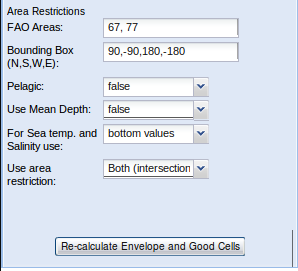
This forms allows users to re-generate the species envelope from the related occurrence cells
The sequent editable fields are displayed:
- Fao Areas restriction : if enabled (see "Use area restriction" field) occurrence cells will be evaluated only if they belong to the specified areas
- Bounding Box : if enabled (see "use area restriction" field) occurrence cells will be evaluated only if they are inside the specified coordinates
- Pelagic : if true, the species envelope is generated considering the species to be pelagic
- Use Mean Depth : specifies if the envelope generation have to consider or not the Mean Depth
- For Sea Temp and Salinity use : allows users to choice if evaluate bottom or surface values
- Use area restriction : specifies if the envelope generation must consider Fao Area restriction, Bounding Box or both
Pressing the button "Re-calculate envelope and good cells", the envelope is re-calculated with the specified settings and loaded in the "Default species environmental tolerance".
Default species environmental tolerance

In this grid is displayed the current selected species envelope. It's possible to edit every parameter either by inserting the wanted value or by re-calculating it.
The envelope has 6 attributes, defined as a maximum / minimum and preferred maximum / preferred minimum values:
- Depth (meters)
- Temperature (Celsius degrees)
- Salinity (psu - Practical Salinity Unit)
- Primary Production
- Distance to Land (Kilo-meters)
- Ice concentration (cover percent)
Users can set the edited values (if any), by pressing the "Commit Envelope" button. Selecting / de-selecting attributes, users can define the parameter evaluation by pressing the "Commit parameter evaluation" button. Users can access the Occurrence cells popup by pressing the "Show Occurrence cells" button. Every customization made to the selected species envelope can be reverted by pressing "Undo Changes".
Occurrence Cells Popup
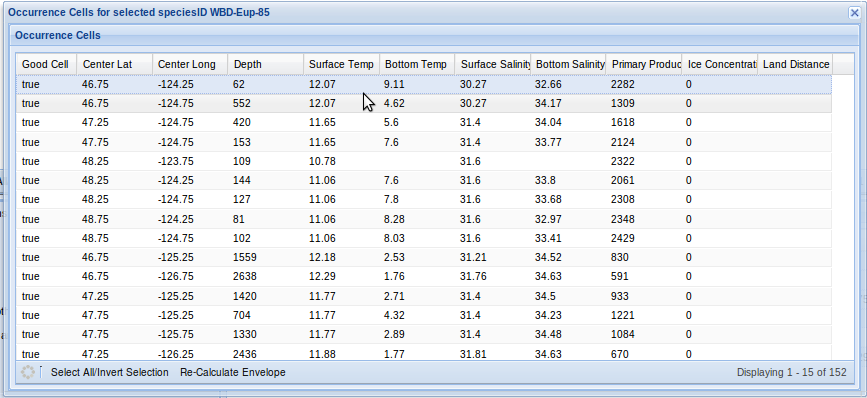
This grid displays all the occurrence cells related to a specified species.
The columns displayed are:
- Good Cell (true | false)
- Center Lat
- Center Long
- Depth
- Surface Temp
- Bottom Temp
- Surface Salinity
- Bottom Salinity
- Primary Production
- Ice Concentration
- Land Distance
Users can re-generate the species envelope by selecting cells to consider as good cell and pressing the "Re-calculate envelope" button from the bottom toolbar. The minimum requested number of cell to generate an envelope is 10.
Area Selection
This part of the interface is similar to the Species Selection section. Users are allowed to select areas to which limit the map generation process, by adding/removing them to the Area basket.
Area List
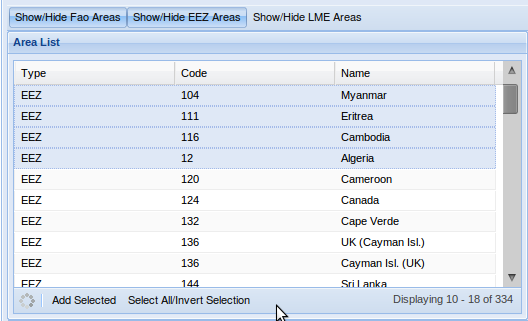
This grid displays all the selectable area, letting a sort operation by each of the contained fields :
- Type - the type of the area which can be FAO, EEZ or LME
- Code - the id of the area
- Name - a human understandable name of the area
In the upper section of the list users can filter areas by their type.
In the bottom toolbar are displayed (from left to right):
- Refresh button
- Add Selected - adds the selected areas to the area basket
- Select All / invert Selection - inverts selection if any, otherwise selects all areas
Area Basket Similarly to the species basket in the Species Selection section, in this grid are displayed all areas inserted in user's area basket.
Generation
In this section users can specify :
- How many AquaMaps object to generate within the current Job submission
- Settings details for each AquaMaps object related to current Job submission
- Which data sources to consider for generating / rendering species distribution probabilities
AquaMaps Objects and Jobs
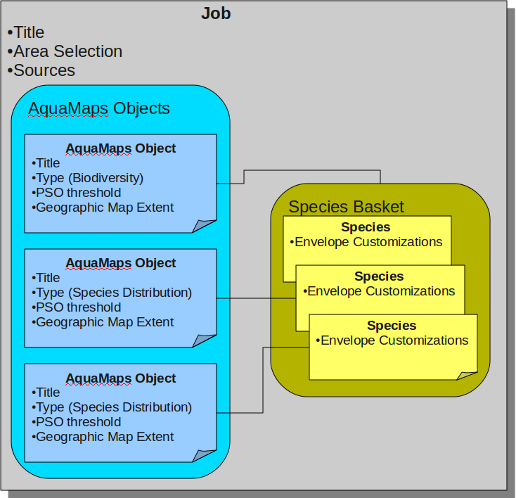
The AquaMaps production VRE is designed to let users produce multiple AquaMaps object per submission. In the upper diagram is explained the relationship between a Job and its related AquaMaps objects.
For each generation submission users can specify different AquaMaps objects to generate, each of them described by :
- Title - a human readable name
- Type - Biodiversity Maps / Species Distribution Maps
- PSO threshold - for Biodiversity Maps the minimum considered species probability
- Geographic Map Extent - a further geographic map generation limit
- Related species - the species selection related to the AquaMaps object (a sub-set of the species basket)
This feature let users to generate various AquaMaps object sharing settings about :
- Global species selection - the user basket, the AquaMaps object can select only species from this set (see Species Selection)
- Species envelopes customization - (see Species Envelope Customization)
- Global Area Selection - a global limitation to map generation (see Area Selection)
- Sources selection - the data sources for the generation process
For instance, Let's assume a user wants to generate :
- Biodiversity Map with PSO threshold 0.5 for the Gadidae Family
- Biodiversity Map with PSO threshold 0.8 for the Gadidae Family
- Species Distribution Maps for each species in Gadidae Family (23 species = 23 AquaMaps objects)
Instead of submitting 25 generation requests (23 Species Distribution + 2 Biodiversity), a user can submit a single Job with 25 related AquaMaps objects with the wanted settings. This approach avoids users to repeat common settings specification process.
Selected Species List
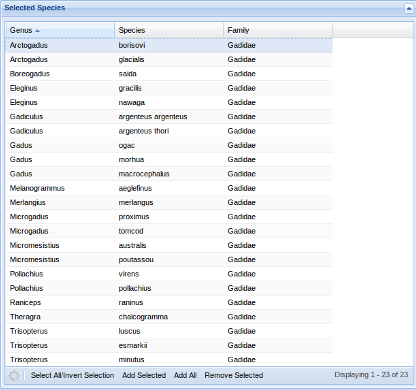
This grid displays the current species basket content (see Species Selection).
In the bottom toolbar of this panel users can find (from left to right) :
- Refresh Button - reloads the list
- Select All / Invert Selection - inverts the selection if any, otherwise selects all species
- Add Selected - adds the selected species to the current displaying AquaMaps object
- Add All - Adds all species from the basket to the current displaying AquaMaps object
- Remove Selected - Remove the selected species from the current displaying AquaMaps object
AquaMaps to generate
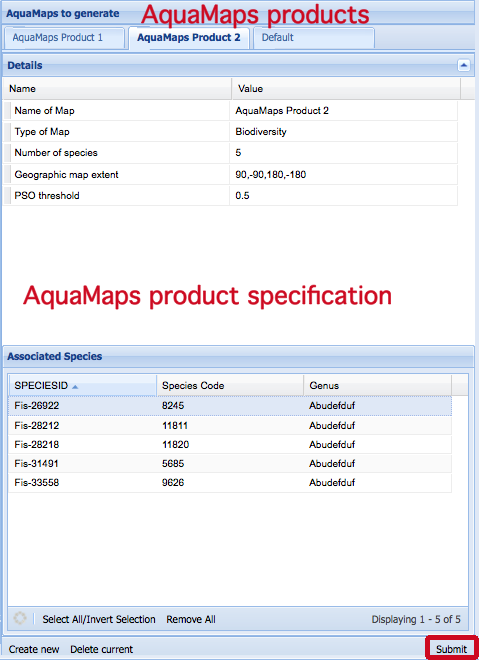
The right section of the Generation interface is where users specify each AquaMaps object settings.
Every AquaMap Object is displayed as a "Tab", and for each of them is displayed (and editable):
- The name of the map
- The type of the map
- The total number of the related species
- The geographic map extent
- The PSO threshold
- A list of all species related to the displaying AquaMaps Object
NB: if a Biodiversity map is set to Species Distribution, the application splits it into a set of Species Distribution AquaMaps objects, one per each species associated to the splitted Biodiversity AquaMaps Object.
In the bottom toolbar of this panel users can find (from left to right) :
- Create New - creates a new AquaMaps object related to the current Job submission
- Delete current - deletes the currently displayed AquaMaps object
- Submit - submits the Job with all the current settings (and related AquaMaps object)
Associated Species Each AquaMaps object is associated to at least one species from the species basket. The grid shown in this section lists all species associated to the currently displayed AquaMaps object. In the bottom toolbar of this panel users can find (from left to right) :
- Refresh Button - reloads the list
- Select All / Invert Selection - inverts the selection if any, otherwise selects all species
- Remove All - Removes all the species from the current displaying AquaMaps object
Sources
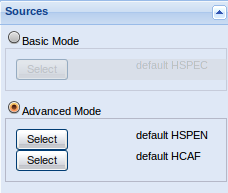
A Job can be submitted in 2 different modes:
- Basic mode - the probability aren't calculated, and a source HSPEC has to be specified. NB: Customizations won't be considered.
- Advanced Mode - forces the system to re-calculate occurrence probabilities (using specified customizations if any). In this mode the user has to specify both HCAF and HSPEN sources.
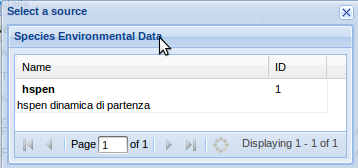
By pressing the "Select" button, users can access to a popup containing all available data sources, where they can specify the one they want to consider for the current Job submission.
View AquaMaps Results
This section of the GUI has the intent of letting users to monitor their submitted AquaMaps objects, viewing all related details. From this point is also possible to save generated objects to the user's workspace, in order to use workspace features in AquaMaps VRE.
Submitted Aquamaps Objects
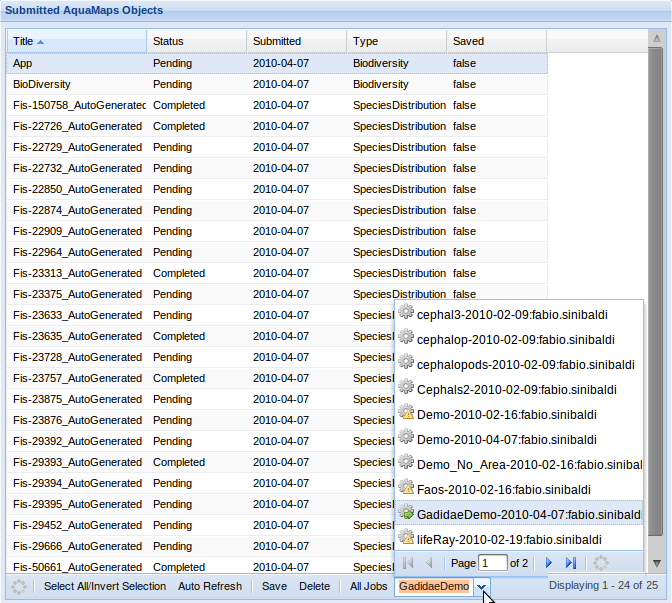
The above grid shows how the interface lets users monitor (at a first sight) their submitted AquaMaps objects.
In the main grid there are all submitted objects, for each of them are shown:
- Title - the name of the map
- Status - the current status of the map (Pending | Generating | Simulating | Publishing | Error)
- Submitted - the date of the submission
- Type - the type of the map
- Saved - a flag indicating if the object has been saved to the user's workspace
Similarly to other grids in the GUI, each of the columns can be used to sort resulting entries.
In the bottom toolbar of this panel users can find (from left to right) :
- Refresh Button - reloads the list
- Select All / Invert Selection - inverts the selection if any, otherwise selects all resulting AquaMaps objects
- Auto Refresh - Enables / disables the auto refresh of the data every 10 seconds
- Save - saves the selected objects to the workspace
- Delete - deletes the selected objects
- All Jobs - clears the current job filter selection
- Filter by Jobs - opens a popup showing the list of all submitted Jobs. Selecting a Jobs, users force the AquaMaps object list to show only that Job related objects.
- Jobs here are in alphabetical order, and are described with
- Status Icon
- Job Name
- Job submission date
- Job author
Map Details
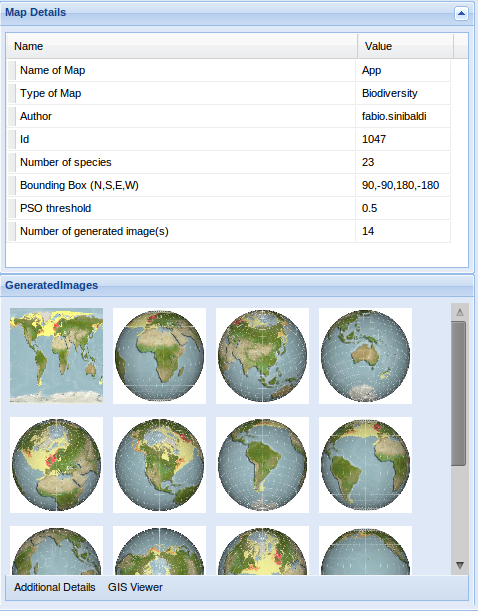
Once an AquaMaps Object is selected in the main list, its details are loaded in the Map Details section.
In the bottom part of this section, a preview of all generated static images is provided. Clicking to a preview, opens a resizeable popup containing the clicked image.
In the bottom toolbar of this panel users can access (from left to right):
- Additional Details - more details about the AquaMaps object generation settings
- Gis Viewer - an advanced GIS interface loaded with the AquaMaps object generated layers
